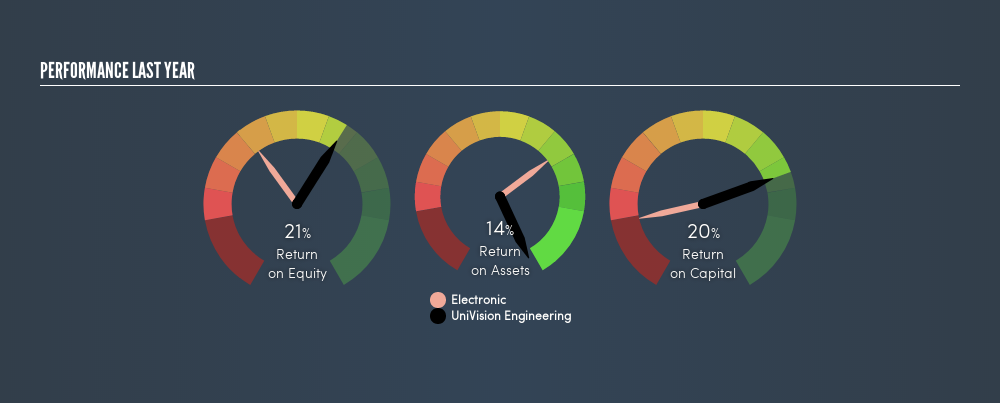UniVision Engineering Limited (LON:UVEL) Earns A Nice Return On Capital Employed

Today we are going to look at UniVision Engineering Limited (LON:UVEL) to see whether it might be an attractive investment prospect. Specifically, we'll consider its Return On Capital Employed (ROCE), since that will give us an insight into how efficiently the business can generate profits from the capital it requires.
First, we'll go over how we calculate ROCE. Second, we'll look at its ROCE compared to similar companies. Then we'll determine how its current liabilities are affecting its ROCE.
What is Return On Capital Employed (ROCE)?
ROCE is a measure of a company's yearly pre-tax profit (its return), relative to the capital employed in the business. In general, businesses with a higher ROCE are usually better quality. In brief, it is a useful tool, but it is not without drawbacks. Renowned investment researcher Michael Mauboussin has suggested that a high ROCE can indicate that 'one dollar invested in the company generates value of more than one dollar'.
So, How Do We Calculate ROCE?
The formula for calculating the return on capital employed is:
Return on Capital Employed = Earnings Before Interest and Tax (EBIT) ÷ (Total Assets - Current Liabilities)
Or for UniVision Engineering:
0.20 = UK£1.5m ÷ (UK£11m - UK£4.0m) (Based on the trailing twelve months to September 2018.)
Therefore, UniVision Engineering has an ROCE of 20%.
See our latest analysis for UniVision Engineering
Is UniVision Engineering's ROCE Good?
ROCE can be useful when making comparisons, such as between similar companies. In our analysis, UniVision Engineering's ROCE is meaningfully higher than the 14% average in the Electronic industry. We consider this a positive sign, because it suggests it uses capital more efficiently than similar companies. Setting aside the comparison to its industry for a moment, UniVision Engineering's ROCE in absolute terms currently looks quite high.
UniVision Engineering delivered an ROCE of 20%, which is better than 3 years ago, as was making losses back then. This makes us wonder if the company is improving.

When considering ROCE, bear in mind that it reflects the past and does not necessarily predict the future. Companies in cyclical industries can be difficult to understand using ROCE, as returns typically look high during boom times, and low during busts. This is because ROCE only looks at one year, instead of considering returns across a whole cycle. How cyclical is UniVision Engineering? You can see for yourself by looking at this freegraph of past earnings, revenue and cash flow.
How UniVision Engineering's Current Liabilities Impact Its ROCE
Short term (or current) liabilities, are things like supplier invoices, overdrafts, or tax bills that need to be paid within 12 months. Due to the way ROCE is calculated, a high level of current liabilities makes a company look as though it has less capital employed, and thus can (sometimes unfairly) boost the ROCE. To check the impact of this, we calculate if a company has high current liabilities relative to its total assets.
UniVision Engineering has total assets of UK£11m and current liabilities of UK£4.0m. As a result, its current liabilities are equal to approximately 35% of its total assets. UniVision Engineering has a medium level of current liabilities, boosting its ROCE somewhat.
Our Take On UniVision Engineering's ROCE
Despite this, it reports a high ROCE, and may be worth investigating further. Of course you might be able to find a better stock than UniVision Engineering. So you may wish to see this freecollection of other companies that have grown earnings strongly.
I will like UniVision Engineering better if I see some big insider buys. While we wait, check out this freelist of growing companies with considerable, recent, insider buying.
We aim to bring you long-term focused research analysis driven by fundamental data. Note that our analysis may not factor in the latest price-sensitive company announcements or qualitative material.
If you spot an error that warrants correction, please contact the editor at editorial-team@simplywallst.com. This article by Simply Wall St is general in nature. It does not constitute a recommendation to buy or sell any stock, and does not take account of your objectives, or your financial situation. Simply Wall St has no position in the stocks mentioned. Thank you for reading.
About AIM:UVEL
UniVision Engineering
UniVision Engineering Limited designs, supplies, consults, installs, and maintains closed circuit televisions and surveillance systems in the People’s Republic of China.
Slightly overvalued with weak fundamentals.
Market Insights
Community Narratives



